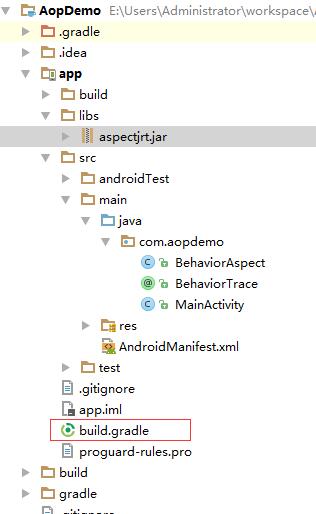这篇博客只是本人在Android进阶学习中AOP面向切面编程的学习笔记,适合入门级选手,如果想深入了解AOP面向切面编程可以找些大牛的博客来阅读。
在没有出现AOP面向切面编程之前谈论的都是OOP,即Object Oriented Programming,面向对象编程。在面向对象里,功能的实现都被划分成一个个独立的模块,每个模块独自干好自己的事情,模块之间通过设计好的接口进行交互;OOP的精髓是把功能或问题模块化,每个模块处理自己的家务事。但是在项目开发中,不是所有的问题用面向对象的思想都能得到很好的解决。
比如:要对项目中某些功能进行用户行为统计,用户在什么时候使用了这些功能,使用了多长等;
面向对象思想:
/**
* 发送文本
*
* @param view
*/
public void btnText(View view) {
//统计用户行为 的逻辑
Log.i(TAG, "文字: 使用时间: " + simpleDateFormat.format(new Date()));
long beagin = System.currentTimeMillis();
//发送文本的代码逻辑
{
SystemClock.sleep(3000);
Log.i(TAG, " 发送文本");
}
Log.i(TAG, "消耗时间: " + (System.currentTimeMillis() - beagin) + "ms");
}
会发现,需要在每个功能的业务逻辑前后添加统计用户行为的代码,这样子不仅代码重复,如果后期需求改变就要对每个地方的代码进行修改,这样子感觉是不是很不好,这个时候就可以使用面向切面编程的思想来解决。
在面向切面编程之前要先下载aspectjrt.jar,
下载地址:
http://www.eclipse.org/aspectj/downloads.php
将下载好的aspectjrt.jar拷贝到libs目录下面,并与项目工程进行关联
compile files('libs/aspectjrt.jar')
接下来还有在app目录下build.gradle文件中进行相应的配置
import org.aspectj.bridge.IMessage
import org.aspectj.bridge.MessageHandler
import org.aspectj.tools.ajc.Main
buildscript {
repositories {
mavenCentral()
}
dependencies {
classpath 'org.aspectj:aspectjtools:1.8.9'
classpath 'org.aspectj:aspectjweaver:1.8.9'
}
}
apply plugin: 'com.android.application'
repositories {
mavenCentral()
}
android {
compileSdkVersion 25
buildToolsVersion "26.0.0"
defaultConfig {
applicationId "com.aopdemo"
minSdkVersion 15
targetSdkVersion 25
versionCode 1
versionName "1.0"
testInstrumentationRunner "android.support.test.runner.AndroidJUnitRunner"
}
buildTypes {
release {
minifyEnabled false
proguardFiles getDefaultProguardFile('proguard-android.txt'), 'proguard-rules.pro'
}
}
}
final def log = project.logger
final def variants = project.android.applicationVariants
variants.all { variant ->
if (!variant.buildType.isDebuggable()) {
log.debug("Skipping non-debuggable build type '${variant.buildType.name}'.")
return;
}
JavaCompile javaCompile = variant.javaCompile
javaCompile.doLast {
String[] args = ["-showWeaveInfo",
"-1.8",
"-inpath", javaCompile.destinationDir.toString(),
"-aspectpath", javaCompile.classpath.asPath,
"-d", javaCompile.destinationDir.toString(),
"-classpath", javaCompile.classpath.asPath,
"-bootclasspath", project.android.bootClasspath.join(File.pathSeparator)]
log.debug "ajc args: " + Arrays.toString(args)
MessageHandler handler = new MessageHandler(true);
new Main().run(args, handler);
for (IMessage message : handler.getMessages(null, true)) {
switch (message.getKind()) {
case IMessage.ABORT:
case IMessage.ERROR:
case IMessage.FAIL:
log.error message.message, message.thrown
break;
case IMessage.WARNING:
log.warn message.message, message.thrown
break;
case IMessage.INFO:
log.info message.message, message.thrown
break;
case IMessage.DEBUG:
log.debug message.message, message.thrown
break;
}
}
}
}
dependencies {
compile fileTree(include: ['*.jar'], dir: 'libs')
androidTestCompile('com.android.support.test.espresso:espresso-core:2.2.2', {
exclude group: 'com.android.support', module: 'support-annotations'
})
compile 'com.android.support:appcompat-v7:25.3.1'
testCompile 'junit:junit:4.12'
compile files('libs/aspectjrt.jar')
}
弄好后就可以进行面向切面编程了,就将上面的统计用户行为的需求用面向切面编程的思想来实现下;
/**
* Created by Administrator on 2017/10/6.
*/
@Target(ElementType.METHOD)
@Retention(RetentionPolicy.RUNTIME)
public @interface BehaviorTrace {
String value();
int type();
}
这个是一个注解类,
@Target该注解在什么地方起作用
ElementType.FIELD 代表的是在属性上
ElementType.METHOD 代表的是在方法上
ElementType.TYPE 代表的是在类上
ElementType.CONSTRUCTOR 代表的是在构造方法上
@Retention该注解在什么时候生效
RetentionPolicy.RUNTIME 运行时生效
RetentionPolicy.CLASS 编译时生效
RetentionPolicy.SOURCE 源码资源
/**
* Created by Administrator on 2017/10/6.
*/
@Aspect
public class BehaviorAspect {
private static final String TAG = "BehaviorAspect";
SimpleDateFormat simpleDateFormat=new SimpleDateFormat("yyyy-MM-dd HH:mm:ss");
/**
* 切点
*/
@Pointcut("execution(@com.aopdemo.BehaviorTrace * *(..))")
public void annoBehavior(){
}
/**
* 切面
* @return
*/
@Around("annoBehavior()")
public Object dealPoint(ProceedingJoinPoint point) throws Throwable{
//执行之前
MethodSignature signature = (MethodSignature) point.getSignature();
BehaviorTrace annotation = signature.getMethod().getAnnotation(BehaviorTrace.class);
String value = annotation.value();
int type = annotation.type();
Log.i(TAG,value+"使用时间: "+simpleDateFormat.format(new Date()));
long beagin=System.currentTimeMillis();
//执行方法
Object object=null;
try {
object=point.proceed();
}catch (Exception e){
}
//方法执行完成
Log.i(TAG,"消耗时间: "+(System.currentTimeMillis()-beagin)+"ms");
return object;
}
}
可以将用户触发行为的逻辑代码改为:
/**
* 发送文本
*
* @param view
*/
@BehaviorTrace(value = "发送文本",type = 3)
public void btnText(View view) {
//统计用户行为 的逻辑
SystemClock.sleep(3000);
Log.i(TAG, " 发送文本");
}
和面向对象的方式相比,代码整洁了不少,同时也便于后期项目的修改。
源码地址:
http://pan.baidu.com/s/1gfNAaTt

